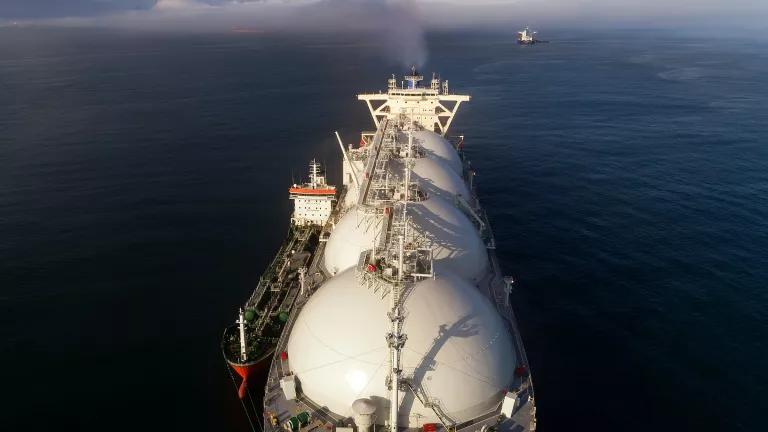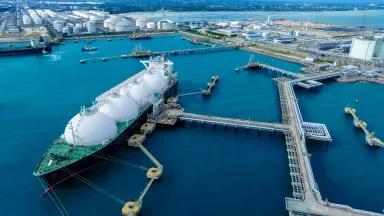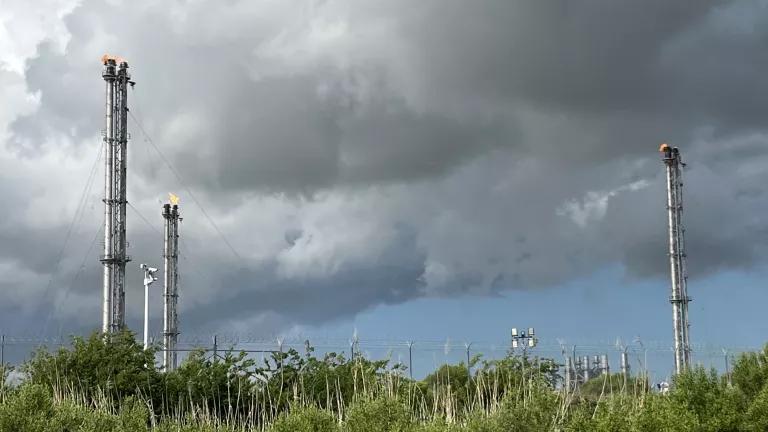A Wake-Up Call to Political and Financial Enablers of Global LNG Expansion
Instead of enabling the dirty fuels of the past through fossil LNG expansion, it is time to enable a just energy transition through renewable energy.

A liquefied natural gas tanker ship in the Sea of Japan
Dreamstime
The global gas market will be overturned by a surge of liquefied natural gas (LNG) export projects that will add 250 billion cubic meters (bcm) of capacity by 2030, according to the International Energy Agency’s (IEA) World Energy Outlook 2023. If this LNG is fully utilized, the greenhouse gas (GHG) emissions impacts will blow past the Paris Agreement’s 1.5-degree Celsius global warming cap. We challenge governments and financial institutions to stop enabling global LNG infrastructure development and redirect efforts toward the tripling of renewable energy production worldwide.
European Union and United States LNG expansion: All downside
You can’t shrink emissions when you’re expanding them. There is simply no place for new oil and gas expansion in the IEA’s updated 2023 Net Zero Roadmap. Yet major economies like the European Union (E.U.) and the United States continue to permit LNG projects, undermining any progress toward achieving their Nationally Determined Contributions (NDCs) and ensuring energy security.
Since Russia invaded Ukraine last year, Europe has added six new LNG terminals, amounting to 36.5 bcm of LNG capacity, despite flattening near-term LNG demand forecasts. In clear contradiction to the E.U.’s NDC to cut GHG emissions by at least 55 percent by 2030, the total E.U. gas build-out of 227.2 bcm could add nearly 950 million tons of carbon dioxide emissions per year. Despite the REPowerEU plan’s aims to rapidly reduce dependence on Russian fossil fuels, E.U. countries still increased Russian LNG imports by 40 percent at a staggering cost of 5.29 billion euros. Europe must address the double disaster of increasing LNG emissions and financing Russia’s LNG industry before it further imperils the global climate and its own energy security.
The Biden administration is complicit in enabling fossil LNG expansion at home and abroad. Supplies from eight operational LNG export facilities propelled the United States to become the world’s top LNG exporter in the first half of 2023. As 18 facilities are approved for construction, and seven more seek regulatory approval, the full, proposed LNG build-out is equivalent to running 681 coal plants each year (2,543 million metric tons of CO2e). This U.S. LNG spree could cause us to overshoot our 2030 NDC by 41 percent. Looking abroad, $900 million of U.S. public financing flowed to support LNG infrastructure globally. Such unfettered expansion sacrifices the health and well-being of communities near the LNG facilities and props up U.S. fracked gas production when demand should be declining.
LNG is a bad investment
Staggering amounts of private finance have been pouring into fossil LNG expansion with no end in sight. Top banks from Japan, Europe, and the United States increased financing to the top 30 LNG companies from $15.2 billion in 2021 to $22.7 billion in 2022, thus accumulating $122.2 billion in LNG private financing since 2016. Every dollar committed to fossil LNG finance is misaligned with the Paris Agreement and detracts from the financial goals set by the Net-Zero Banking Alliance and Glasgow Financial Alliance for Net Zero.
Public finance into fossil LNG fares no differently. A recent report from Oil Change International- found that G20 government institutions were involved in financing for 82 percent of new LNG export terminal capacity built from 2012 to 2022. Through public finance loans, guarantees, and equity investments, Japan, China, United States, and South Korea were the top four funding countries. Spotlighting Japan, the government made a $10 billion commitment to expand LNG markets in Asia and also offered $10 billion to ASEAN energy ministers to finance LNG and renewables projects. And South Korea, where major LNG carrier shipyards are located, has financed $47 billion on building LNG carriers in the last decade.
Public and private finance into fossil LNG is an expensive bet that could expose institutions to stranded asset risks in the coming years. Along the LNG value chain, while 650 LNG carriers are operating, 320 carriers on order are vulnerable to becoming stranded assets. Continued reliance on European and Asian gas market growth may be a grave mistake as renewable energy takes a greater share of the energy mix. Given the uncertainty around global gas in the long term, financial institutions should be revising their assessments of returns on investment and profitability of these LNG projects.
Mounting political opposition against fossil LNG from top enablers
Global LNG expansion is costly, not only from an economic perspective but also for communities living adjacent to the LNG infrastructure build-out. Within developed countries, there is a steady drumbeat of resistance to gas and LNG that is aligned with developing countries. Irish campaigners were successful in preventing the permit for Shannon LNG, following a ban on fracking in Ireland in 2017 and the landmark 2021 Policy Statement on the Importation of Fracked Gas. In a recent visit to the U.S. Gulf Coast, Kathrin Hennenberger, a German Parliament politician, spoke out against Germany’s involvement in financing LNG infrastructure that is unsafe in light of the climate crisis. These sentiments are similarly matched by Oregon’s U.S. Senator Jeff Merkley, who voiced serious concerns against Louisiana’s Calcasieu Pass 2 LNG terminal. And given the climate and social imperative to halt LNG expansion, it is only a matter of time before the political tides shift away from fossil LNG.
A renewable energy future is possible
Taking fossil LNG out of the equation, there is a promising renewable energy future for developing countries. Numerous countries in Latin America and the Caribbean have led by example, meeting energy needs through renewable energy instead of relying on LNG and gas. In the last decade, Chile went from generating 0.6 percent of wind and solar to 28 percent in 2022, overtaking coal. Likewise in Brazil, the installed capacity of wind and solar surpassed 60 gigawatts and equals twice as much as oil, coal, and gas thermal plants combined. In that regard, opposition to 19 proposed LNG terminals has been brought to the attention of Brazilian lawmakers. Countries in the region should invest in sustainably ramping up their renewable energy resources rather than letting LNG interests create even greater fossil fuel dependence.
Instead of enabling the dirty fuels of the past through fossil LNG expansion, it is time to enable a just energy transition through renewable energy. Fossil LNG is becoming less cost competitive and more financially risky, and it is facing growing political and community opposition. Tried-and-true renewable energy is a scalable alternative in many countries and must be the top priority for public and private financiers. At COP28, world leaders must heed the clarion call for the tripling of renewable energy production and usher in the phaseout of fossil fuels.




